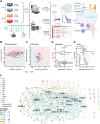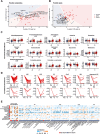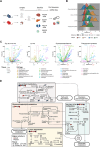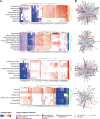Multi-Omics and -Organ Insights into Energy Metabolic Adaptations in Early Sepsis Onset
- PMID: 40411399
- PMCID: PMC12376650
- DOI: 10.1002/advs.202504418
Multi-Omics and -Organ Insights into Energy Metabolic Adaptations in Early Sepsis Onset
Abstract
Systemic metabolic dysregulation in sepsis critically impacts patient survival. To better understand its onset, untargeted serum metabolomics and lipidomics are analyzed from 152 presymptomatic patients undergoing major elective surgery, and identified key metabolites, including serine and aminoadipic acid, that differentiate postoperative uncomplicated infection from sepsis. Using single-nucleus RNA sequencing data from an in vivo mouse model of sepsis, tissue-independent down-regulation and tissue-specific differences of serine and energy-related genes including key module roles for the mitochondria-linked genes, Cox4i1, Cox8a, and Ndufa4 are identified. Finally, serine-dependent metabolic shifts, especially in the liver, are revealed by using 12C/13C murine data with labeled serine, and link altered activity of the serine hydroxymethyltransferase (SHMT) cycle with perturbed purine metabolism during sepsis. This study demonstrates the close interrelationship between early metabolite changes and mitochondrial dysfunction in sepsis, improves the understanding of the underlying pathophysiology, and highlights metabolic targets to prospectively treat presymptomatic, but at-risk, patients.
Keywords: cell–cell communication; energy imbalance; lipid metabolism; metabolic modeling; sepsis biomarkers; single‐nucleus RNA sequencing (snRNA‐Seq).
© 2025 The Author(s). Advanced Science published by Wiley‐VCH GmbH.
Conflict of interest statement
M.S. received grants from NewB, Apollo Therapeutics, and UCL Technology Fund and others from Abbott, Amormed, bioMérieux, Biotest, Deltex Medical, Fresenius, Mindray, NewB, Pfizer, Radiometer, Roche Diagnostics, Safeguard Biosystems, Shionogi, and Spiden outside of this project. M.S. is an unpaid advisor to Presymptom Health Ltd, hemotune, deepUll, and Santersus, and R.L. is a part‐time advisor to Presymptom Health Ltd.
Figures







Similar articles
-
Early Sepsis Metabolic Changes in Kidney and Liver Precede Clinical Evidence of Organ Dysfunction.Am J Respir Cell Mol Biol. 2025 Aug;73(2):299-309. doi: 10.1165/rcmb.2024-0391OC. Am J Respir Cell Mol Biol. 2025. PMID: 39918954
-
Systemic Inflammatory Response Syndrome.2025 Jun 20. In: StatPearls [Internet]. Treasure Island (FL): StatPearls Publishing; 2025 Jan–. 2025 Jun 20. In: StatPearls [Internet]. Treasure Island (FL): StatPearls Publishing; 2025 Jan–. PMID: 31613449 Free Books & Documents.
-
Identification of sepsis-associated mitochondrial genes through RNA and single-cell sequencing approaches.BMC Med Genomics. 2024 May 3;17(1):120. doi: 10.1186/s12920-024-01891-x. BMC Med Genomics. 2024. PMID: 38702721 Free PMC article.
-
The emerging role of multiomics in aging research.Epigenomics. 2025 Sep;17(13):897-904. doi: 10.1080/17501911.2025.2533111. Epub 2025 Jul 20. Epigenomics. 2025. PMID: 40684321 Review.
-
A narrative review of metabolomics approaches in identifying biomarkers of doxorubicin-induced cardiotoxicity.Metabolomics. 2025 May 17;21(3):68. doi: 10.1007/s11306-025-02258-8. Metabolomics. 2025. PMID: 40381141 Free PMC article. Review.
References
-
- Singer M., Deutschman C. S., Seymour C., Shankar‐Hari M., Annane D., Bauer M., Bellomo R., Bernard G. R., Chiche J. D., Coopersmith C. M., Hotchkiss R. S., Levy M. M., Marshall J. C., Martin G. S., Opal S. M., Rubenfeld G. D., Poll T. D., Vincent J. L., Angus D. C., J. Am. Med. Assoc. 2016, 315, 801.
-
- Rudd K. E., Johnson S. C., Agesa K. M., Shackelford K. A., Tsoi D., Kievlan D. R., Colombara D. V., Ikuta K. S., Kissoon N., Finfer S., Fleischmann‐Struzek C., Machado F. R., Reinhart K. K., Rowan K., Seymour C. W., Watson R. S., West T. E., Marinho F., Hay S. I., Lozano R., Lopez A. D., Angus D. C., Murray C. J. L., Naghavi M., Lancet 2020, 395, 200. - PMC - PubMed
-
- Evans L., Rhodes A., Alhazzani W., Antonelli M., Coopersmith C. M., French C., Machado F. R., Mcintyre L., Ostermann M., Prescott H. C., Schorr C., Simpson S., Wiersinga W. J., Alshamsi F., Angus D. C., Arabi Y., Azevedo L., Beale R., Beilman G., Belley‐Cote E., Burry L., Cecconi M., Centofanti J., Coz Yataco A., De Waele J., Dellinger R. P., Doi K., Du B., Estenssoro E., Ferrer R., et al., Intens. Care Med. 2021, 47, 1181. - PMC - PubMed
-
- Giamarellos‐Bourboulis E. J., Aschenbrenner A. C., Bauer M., Bock C., Calandra T., Gat‐Viks I., Kyriazopoulou E., Lupse M., Monneret G., Pickkers P., Schultze J. L., van der Poll T., van de Veerdonk F. L., Vlaar A. P. J., Weis S., Wiersinga W. J., Netea M. G., Nat. Immunol. 2024, 25, 19. - PubMed
MeSH terms
Grants and funding
LinkOut - more resources
Full Text Sources
Medical
